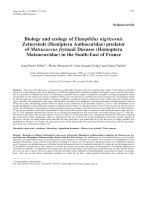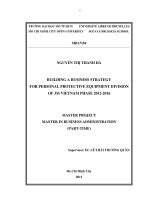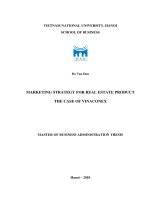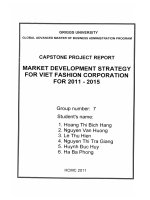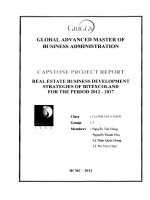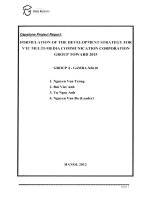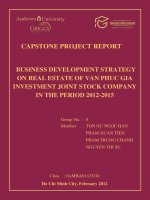Market development strategy for real estate business of FPT corporation in the south east of Vietnam during 2012 to 2016.
Bạn đang xem bản rút gọn của tài liệu. Xem và tải ngay bản đầy đủ của tài liệu tại đây (1.48 MB, 112 trang )
I H C M TP HCM
HO CHI MINH CITY OPEN UNIVERSITY
UNIVERSITÉ LIBRE DE BRUXELLES
SOLVAY BRUSSELS SCHOOL
MBAVB4
MARKET DEVELOPMENT STRATEGY
FOR REAL ESTATE BUSINESS OF FPT CORPORATION
IN THE SOUTH-EAST OF VIETNAM DURING 2012-2016
MASTER PROJECT
MASTER IN BUSINESS ADMINISTRATION
(PART-TIME)
Ho Chi Minh City
(2011)
Page |i
STATEMENT OF COMMITMENT
I hereby, Trinh Ngoc Bien committed my honesty that this thesis for MBA
degree is my own work. I declare that all source of information that I use in this paper
is reliable. The information was re-produced from publication information or internal
source with permission of owner is clear and duty cited. I further commit that it does
not constitute any previous work whether published or otherwise.
P a g e | ii
ACKNOWLEDGMENT
MBA is a challenging journey but interesting one. This program inspires me to
touch and enrich my knowledge. At the end of this program, I understand that MBA is
just a new starting point in my life and my study career.
To complete this project, I have received a lot support from many people who
are professors of program, my colleagues, my classmates, my partners and my
family. I would like to acknowledge the help of all.
First and foremost, I would like to thank my family, especially my daughter
because of giving me a great encouragement and support to complete not only 2years journey of this MBA program but also all struggles I have met in study as well
as work.
I would like to express my deeply thanks and full of respect to my supervisor,
Assoc. Prof. Lê Nguy n H u, for all challenges, enthusiastic encouragement and
precious comments. By the advice of Professor, I completed not only my final project
but received a lot of knowledge and improve my experience in solving problem of
business also.
I would like to express my thanks to my all colleagues in FPT Corporation; Mr.
Hoàng Nam Ti
c, Mr. Ph m Tùng Lâm, Dr. Nguy
Nguy n Th H ng Hà, Mr Nguy
c and many others. By your support to me
in group discussion and in-depth interview, your great opinions and ideas in
appropriate strategie formulation for real estate is helpful for me in this final project.
I also would like to express my thanks for Mr. Phan Vu An, who not only helped
me to collect secondary data and useful reference documents but reviewed this
report and corrected my English and gave valuable comments also.
Last but not least, I would like to take this change to present my thanks to
Solvay program, Open University, all professors, all coordinators and all classmates
at MBAVB4 who have accompanied me in this journey.
HCMC, February 20th, 2012
P a g e | iv
ABSTRACT
Purpose This study aims to formulate a strategy to market development for
real estate business of FPT until year 2016.
As one of the biggest private enterprises in growing economy of Vietnam, FPT
were recognized as the biggest enterprise in the industry of Information and
Computer Technology (ICT) in Vietnam. After 20 years of development, because of
some reasons and chance, FPT wants to diversify its business into some new
unrelated industries such as banking, securities exchange, fund management and
real estate. Believing that ICT will continue to contribute to human life seriously; FPT
aims to use ICT as core competence to make value for their products or service.
Framework of study The study is constructed based on a comprehensive
strategic-management model (David, 1988). Based on this model, the study applied
Michael Porter
external
environment factors of real estate industry. By this analysis, the opportunities and
threats were figured out and evaluated. The study analyzed internal environment
factors of FPT also. By analysis of internal environment factors the strengths and
weaknesses of FPT were figured out and evaluated. Based on result of analysis
external and internal environment factors, the matrix of strength; opportunities;
weakness and threats (SOWT) was formulated. This study used SWOT matrix and
concept of generic strategy (Michael Porter, 1985) to formulate alternative market
development strategies for real estate business of FPT Corporation from now to
2016. For more objectively and feasibility of strategy, this study used Quantitative
Strategic Planning Matrix (QSPM) to evaluate strategies and chose the best one for
the firm
Key Findings
Focus on South-East region, that is the most dynamic
economic region of Vietnam this study found that real estate market in Vietnam is in
downturn but it is promising and profitable industry in coming years. Because of
dynamic urbanization trend and high demand of housing, development new township
in suburban or vicinity town of Ho Chi Minh City is tendency in South-East. Two major
recommendations are (1) FPT should build townships that focus on ICT life. FPT
towns will convergence of ICT enterprises and ICT training centers, (2) the new way
to acquisition land and compensation, which saves time, eliminates conflicts and
avoids a large part of financial pressure.
Originality/Value
This study helps to figure out the opportunities, threats,
strength and weakness of FPT in real estate business. It also defined three
alternative strategies to market development to real estate business of FPT.
Key words Strategy, real estate,
rces, Resource base
view, SWOT, QSPM, Housing demand, Construction Vietnam and South-East.
Page |v
TABLE OF CONTENT
STATEMENT OF COMMITMENT ................................................................................ I
ACKNOWLEDGMENT ................................................................................................ II
................................................................................................ III
ABSTRACT............................................................................................................... IV
TABLE OF CONTENT ............................................................................................... V
LIST OF ABBREVIATION ...................................................................................... VIII
LIST OF TABLES ..................................................................................................... IX
LIST OF FIGURES.................................................................................................... IX
CHAPTER 1: INTRODUCTION .................................................................................. 1
1.1: RATIONALE OF STUDY ..................................................................................... 1
1.2: PROBLEM STATEMENT .................................................................................... 2
1.3: SCOPE AND LIMITATION OF STUDY ............................................................... 3
1.4:STUDY FRAMEWORK ......................................................................................... 4
1.5: STRUCTURE OF RESEARCH ............................................................................ 4
CHAPTER 2: LITERATURE REVIEW ........................................................................ 5
2.1: STRATEGY AND STRATEGIC MANAGEMENT ................................................ 5
2.2: TYPE OF STRATEGIES ...................................................................................... 5
2.3: STRATEGIC MANAGEMENT PROCESS ........................................................... 7
2.3.1: VISION AND MISSION ........................................................................................ 8
2.3.2: EXTERNAL ENVIRONMENT ANALYSIS .................................................................. 9
2.3.2.1: Macro Environment Analysis ................................................................ 10
2.3.2.2: Micro Environment Analysis ................................................................. 10
2.3.3: INTERNAL ENVIRONMENT ANALYSIS ................................................................. 13
2.3.4: LONG-TERM OBJECTIVE .................................................................................. 13
2.3.5: STRATEGY FORMULATION AND STRATEGIC CHOICE ............................................ 14
2.3.6: STRATEGY IMPLEMENT ................................................................................... 17
CHAPTER 3: ANALYSIS
ENVIRONMENT ........................................................................................................ 19
3.1: MACRO ENVIRONMENT ANALYSIS ............................................................... 19
3.1.1: POLITICAL AND LEGAL ENVIRONMENT ............................................................... 19
3.1.2: SOCIAL ENVIRONMENT .................................................................................... 21
3.1.3: ECONOMIC ENVIRONMENT ............................................................................... 28
3.1.4: TECHNOLOGY ENVIRONMENT ........................................................................... 30
3.2: MICROENVIRONMENT ANALYSIS .................................................................. 31
3.2.1: REAL ESTATE MARKET OVER VIEW.................................................................... 31
P a g e | vi
3.2.2: INDUSTRY COMPETITIVENESS AND COMPETITOR ANALYSIS ................................. 38
3.2.2.1: Barrier of entry ...................................................................................... 38
3.2.2.2: Substitute of products ........................................................................... 40
3.2.2.3: Bargaining power of buyer .................................................................... 41
3.2.2.4: Bargaining power of supplier. ............................................................... 41
3.2.2.5: Competitor analysis (rivalry among Industry) ........................................ 42
3.3: SUMMARY OF COMP
AND THREATS ................... 44
3.3.1: OPPORTUNITIES ............................................................................................. 44
3.3.2: THREATS ....................................................................................................... 45
3.4 EXTERNAL FACTOR EVALUATION MATRIX .................................................. 46
CHAPTER 4: ANALYSIS OF INTERNAL ENVIRONMENT OF REAL ESTATE
BUSINESS OF FPT .................................................................................................. 50
4.1: INTRODUCTION TO FPT CORPORATION ...................................................... 50
4.2: ORGANIZATION STRUCTURE OF FPT CORPORATION ............................... 52
4.2.1 ORGANIZATION CHART ..................................................................................... 52
4.2.2 CORPORATION STRATEGY AND MANAGEMENT SYSTEM ....................................... 54
4.2.3 HUMAN RESOURCE AND CORPORATE CULTURE ................................................. 57
4.3: FINANCIAL ANALYSIS ..................................................................................... 60
4.4: OPERATION OF REAL ESTATE BUSINESS OF FPT CORPORATION ......... 63
4.4.1: GOAL OF REAL ESTATE BUSINESS .................................................................... 63
4.4.2: MARKET SEGMENTATION ................................................................................ 64
4.4.3: MAJOR SUPPLIERS ......................................................................................... 65
4.4.4: INTERNAL SERVICES ....................................................................................... 67
4.4.5: INVESTMENT ACTIVITIES .................................................................................. 67
OT OF REAL ESTATE BUSINESS ................................. 68
4.5.1: STRENGTHS ................................................................................................... 68
4.5.2: WEAKNESSES ................................................................................................ 68
4.6: INTERNAL FACTORS EVALUATION (IFE) MATRIX ....................................... 69
CHAPTER 5: FORMULATING MARKET DEVELOPMEN
REAL ESTATE BUSINESS IN SOUTHERN VIETNAM ........................................... 72
5.1: SWOT ANALYSIS ............................................................................................. 72
5.2: SWOT STRATEGY ............................................................................................ 75
5.3: STRATEGY FORMULATION AND CHOICE..................................................... 76
5.3.1: VISION AND MISSION UNTIL 2016 ..................................................................... 76
5.3.2: MARKET DEVELOPMENT STRATEGY FOR
S REAL ESTATE IN SOUTH-EAST
REGION OF VIETNAM ................................................................................................. 77
5.3.2.1: Cost Leadership Strategy ..................................................................... 77
5.3.2.2: Differentiation Strategy ......................................................................... 79
5.3.2.3: Focus Strategy...................................................................................... 80
P a g e | vii
5.4: STRATEGY EVALUATION
QUANTITY STRATEGIC PLANNING MATRIX . 81
5.5: IMPLEMENT STRATEGY.................................................................................. 85
CHAPTER 6: CONCLUSION AND RECOMMENDATION ....................................... 89
REFERENCE ............................................................................................................ 90
APPENDIX ................................................................................................................ 92
APPENDIX 1: LIST OF COUNTRIES RECOGNITION VIETNAM HAS MARKET
ECONOMY ................................................................................................................ 92
APPENDIX 2: LIST OF INTERVIEWEES FOR SWOT MATRIX .............................. 93
APPENDIX 3: SAMPLE OF INTERVIEW FOR WEIGHTED SCORE OF EFE
MATRIX..................................................................................................................... 94
APPENDIX 4: SAMPLE OF INTERVIEW FOR WEIGHTED SCORE OF IFE MATRIX
.................................................................................................................................. 97
APPENDIX 5: RESULT OF INTERVIEW FOR WEIGHTED SCORE OF SWOT
MATRIX..................................................................................................................... 99
APPENDIX 6: LIST OF PARTNERS OF FPT IN ICT FIELD. ................................. 103
P a g e | viii
LIST OF ABBREVIATION
BOD
: Board of Directors
BRVT : Ba Ria Vung Tau Province
CBD
: Central Business Districts
EU
: Europe
exFPTer: Person, who worked for FPT and stop now
FDI
: Foreign Direct Investment
FPTer : Person, who are working for FPT
GSO
: General Statistic Office of Vietnam
HCMC : Ho Chi Minh City
ICT
: Information Computer Technology
MOC
: Ministry of Construction
NA
: National Assembly
PPP
: Public Private Partnership
QSPM : Quantitative strategic planning matrix
REB
: Real Estate Business
REM
: Real Estate Market
SRV
: Socialist republic of Vietnam
UN
: United Nation
VCCI
: Vietnam Chamber of Commercial and Industry
VNR500: List of top 500 biggest enterprises of Vietnam
WTO
: World Trade Organization
P a g e | ix
LIST OF TABLES
Table 2.1: The SWOT Matrix ............................................................................. 15
Table 2.2 Quantitative strategic planning matrix ................................................ 16
Table 3.1: Demography density of South-East region ....................................... 25
Table 3.3: The net immigrant rate of Provinces in South East .......................... 27
Table 3.4: The growth rate of population of Provinces in South-East ................ 27
Table 3.5: Contribution of real estate industry to whole economy of Vietnam in
nine years at the beginning of 21 century .......................................................... 34
Table: 3.6: Index of housing price/personal income .......................................... 36
Table 3.7: Estimate Need of Urbanite construction area of Vietnam ................. 37
Table 3.8: Estimate Need of Urbanite construction area of South-East region in
the year 2020..................................................................................................... 37
Table: 3.9 External Factor Evaluation (EFE) Matrix of FPT ............................... 46
......................................................... 60
Table 4.2: FPT profit before tax in last five year ................................................ 60
Table 4.3: Brief of Cash flow of FPT in last five yeas ........................................ 62
Table 4.4: Internal factors evaluation matrix (IFE Matrix) .................................. 69
Table 5.1: Benchmark key requirement of overall cost leadership strategy ....... 79
Table 5.2: Benchmark key requirement of differentiate strategy ........................ 80
Table 5.3: Quantitative Strategic Planning Matrix .............................................. 82
Table 5.4: Summary of strategy evaluation ....................................................... 85
LIST OF FIGURES
Figure 2.1: A Comprehensive Strategic management model .............................. 7
Figure 2.2: Forces driving Industry competition ................................................. 11
Figure 2.3: The strategy formulation analytical framework ................................ 14
Figure 2.4: Applied framework of study ............................................................. 15
Figure 3.1: History of legal about Land and REB in RSV................................... 21
Figure 3.2: Urban population divided to geographic region (in million) .............. 22
Figure 3.3: The ratio of urban population in regions of Vietnam ........................ 23
Figure 3.4: Scale of urbanite in provinces of South-East Vietnam ..................... 24
Figure 3.5: Household and House Ownership in South-East............................. 25
Table 3.2: Growth rate of household in South-East during 1999-2010 .............. 26
Figure 3.6: Basic factors of macro economy of Vietnam.................................... 28
Figure 3.7: 20 years development of real estate market in Vietnam .................. 33
Figure 3.8: Number of real-estate enterprise from year 2000 to 2009 ............... 33
Figure 3.9: Structure of demand of residential place in HCMC .......................... 36
Figure 4.1 Changing of identification factors of FPT .......................................... 51
Figure 4.2 Organization chart by business field of FPT ..................................... 53
Figure 4.3: A typical organization chart of subsidiary company of FPT ............. 54
Figure 4.4: One FPT strategy and milestones ................................................... 55
Figure 4.5: One FPT Diagram ........................................................................... 56
Figure 4.5: Growth of personnel ........................................................................ 58
Figure 4.6: Goals of Real estate Business of FPT ............................................. 63
Page |1
Chapter 1: Introduction
CHAPTER 1: INTRODUCTION
1.1: Rationale of study
FPT Corporation has been one of the top five biggest private companies in
Vietnam for recent years. Started as a government company in 1988, FPT was
equitized in 2001 and listed in Ho Chi Minh Stocker Exchange (HOSE) in 2006. FPT
is well known as ICT Company in Vietnam with core competences as below:
-
Software development outsourcing services: Focus on Japanese market and
EU, America recently. FPT is the biggest player in this area in Vietnam today.
-
Informatics System Integration: Provide system integration for domestic
market (Government Agency and B2B business). This is very strong competence of
FPT and FPT is market leader.
Game
Telecommunication services: Provide Internet and ADSL services, IP Phone,
online,
social
network
as
www.banbe.vn,
online
magazine
as
www.vnexpress.net or www.ngoisao.net , etc.
-
Education: FPT University especially focuses on Informatics science.
-
Informatics and telecom equipment Trading: One of important business sector
of FPT, which is contributing a largest portion of annual corporate revenue. This is
one of traditional business of FPT Corp.
After over a decade of development, FPT obtained many achievements in its
core business in 2006. In period from 2002 to 2006, the average annual revenue
growth rate of FPT was about 60%-70% per year. In term of profit, the growth rate
was the same. By good developing stage of firm, FPT accumulated amount of
surplus capital and decided to diversify its business to some new business sectors.
Besides, after many years invested to provide short-term service, FPT had uncertain
financial position in long-term perspective. There was lack of long-term investment or
long-term asset in balance sheet of FPT. This image of financial structure of
company can bring bad point of view from investor when they are concerning about
opportunity of increasing market value of company.
Therefore, FPT joined into real estate market in the end of year 2006.
Likewise, in year 2006, FPT invested to a big real estate project in Da Nang
city, which is known as FPT city Da Nang. This is a mega real estate project with total
Page |2
Chapter 1: Introduction
areas of land is about 181 hectares square. This scale is typical medium town in Viet
Nam.
Year 2007 was the prosperous year of Vietnamese real estate market.
Nevertheless, unfortunately, from 2008 until now, real estate market was
recessionary and many new comers in this market were stuck. FPT real estate
business was unexceptional case.
Now, FPT still perseveres in pursuing real estate business to keep real estate
in FPT business structure. However, this business future has been poor image.
Exception FPT City Da Nang, FPT real estate business is still standby, waited and
sees, and seeks opportunities in Hanoi and HCMC, which are two main real estate
markets in Vietnam. Eventually that, the annunciation of FPT city Da Nang is
important mile stone of FPT on the way it enters into competitive and very risk market
in Viet Nam.
still be a big
and difficult question for the FPT Corporation. There was no any concrete planning or
idea for this business sector, FPT still continue feeding this business with inexplicit
return in the near future. Hence, this study is necessary for FPT to make decision for
its own real estate business.
1.2: Problem statement
, Land belongs to nation. Because it is limited
resource and by the state of legal, in Vietnam, obtains land as a kind of businesses
resource is important with most of Vietnamese companies. The firm, which obtains
proprietary of land, can have great opportunity and threat certainly. In case of
increasing market, it can give the chance to increase value of firm very quickly but in
case of crisis or reaccessioning market, it can give disaster. However, investment to
real estate in Vietnam still important and profitable investing channel if we determine
in medium term or long-term aspect.
Go along with trend on the market, FPT diversified their business to real estate
in the end of year 2006. This time, market was very animated and almost players on
real estate market can seek huge money by the dynamic market. At that time, FPT
joined to real estate market as a new player but they had lack of direction of main
business and very poor determination about their core competence in this
Page |3
Chapter 1: Introduction
playground. In other hand, the economic crisis had influenced to real estate market
and made it downsizing in last some years. Therefore, FPT had been being standstill
with their real estate business now.
In summary, real estate business is very important and new business of FPT
but FPT seems not considered or prepared enough before lunched. This situation
leads to problems that FPT must face very big questions about real estate business
as
and
The Southern of Vietnam or HCMC and vicinity are the prominent hub of
economy and dynamic areas of Vietnam. FPT had deployed their real estate
business activities in HCMC since year of 2007; FPT expected that this branch can
brought out some pilot opportunities by advantage of dynamic market of HCMC and
its vicinity. Until now, because of economic crisis, real estate market in Southern was
be fall in silent but this market still potential to growth again. If FPT want to success in
real estate business likes they did with other business, they should examine the real
estate market in the Southern of Vietnam.
Therefore, this study project is to formulate the market development
strategy for FPT real estate business in period 2012
2016 in South-East of
Vietnam
Specially, this study is to concentrates:
- To evaluate External and Internal environment of FPT Land
- To create Strategy options and defined suitable one for FPT Land
- To recommendation idea to successful in implementation strategy
That is reason why this study needs to answer question as below:
- How can FPT enter to these emergent areas?
- What are kinds of real estate product that FPT should invest?
- What are core concepts of products that FPT should determines to coherence with
strategy of FPT in corporation level?
1.3: Scope and limitation of study
This study focuses on analysis and evaluation the current environment of FPT.
From there, the study aims to formulate a suitable market development strategy for
Page |4
Chapter 1: Introduction
real-estate business of FPT Corporation in next five years. However, only
concentrating on the South-East area is the limitation of this study
1.4:Study framework
This study is to solve business problem. Thus the chosen methods must
comply with objectives of study as formulating strategy in the 1.2. The study
framework formulated as below:
- Collect second data and analysis
- Conduct in-deep interview with experts and managers of company
Base on analysis secondary data about micro and macroeconomic
evaluate external
factor evaluation (EFE) matrix and uses Resource Base View method to evaluate
internal factor evaluation (IFE) matrix.
After building EFE and IFE matrix is combination of EFE matrix and IFE matrix
into SWOT matrix and evaluate factors of SWOT matrix.
Last step of this research is use Quantitative Strategic Planning matrix to
evaluate strategies and make a choice of suitable strategies for the firm.
All above step flow to framework of comprehensive strategic management
model by David (1988)
1.5: Structure of Research
This study is organized into six chapters. Chapter 1 introduces the research
including rationale of research, research problem, research objectives and research
questions. Chapter 2 provides literature review, include definitions and concepts of
strategy formulation. Chapter 3 is analysis external factors affecting to real-estate
business of FPT in South-East market, Vietnam. Chapter 4 introduces FPT
Corporation and its owned real-estate business, then analysis of internal factors of
this business and SWOT analysis. Chapter 5 discusses about appropriate strategy
for FPT in develop its market in South-East Vietnam. The content of this chapter is
suggested strategy for FPT in South-East Vietnam. The last chapter of this study is
the summary and recommendation to be succeeded on implementation of strategy.
Page |5
Chapter 2: Literature review
CHAPTER 2: LITERATURE REVIEW
2.1: Strategy and strategic management
Nowadays, there are many definitions of strategy and strategic management. In
1
general term,
definition is
or other simple
method or plan chosen to bring about a desired future, such
as achievement of a goal or solution to a problem 2.
Strategies of organization are things related to actions of organization that
Strategic management incorporates major changes of direction for the whole
business of companies. Every company has their owned objectives. Company keeps
running because these are some of its existent objects. While objects of company
exist as a plan of destination of company along the time, the environment of company
and business activities of company are changeable. All these elements affect to the
company and this affection forces company moves to adapt with the change of
business condition elements.
Companies succeed if their strategies are appropriate for the circumstance
they face, feasible in respect of their resource, skills and capability and desirable to
their stakeholders
those individuals and groups, both internal and external, who
have stake in and influence over the business. Simply, strategy is fundamentally
rgets
plus, of
course the ability to sustain fit over the time and in changing of circumstances. 3
In summary, strategic management does not only aim to establish and build
strategy of company but must drive strategy in coherence with the business
circumstance also.
2.2: Type of strategies
Based on purpose of strategy, Fred R. David (2009) categorized the strategies
into 11 types of alternatives strategies that enterprise could pursue. They are:
1
www.investorword.com
www.businessdictionary.com
3
th
John L. Thomson; Frank Martin. (2005), Strategic management the 5 edition, Thomson Learning,
UK.
2
Page |6
Chapter 2: Literature review
forward integration; backward integration; horizontal integration; market penetration;
market development; product development; related diversification; unrelated
diversification; retrenchment; divestiture and liquidation.
Forward integration, backward integration and horizontal integration are
sometime collectively referred as vertical integration, which support firms expand its
business by increase control over suppliers or distributors or
competitors.
Market penetration, market development and product development are
sometime collectively referred as intensive strategies which support for the firm in
gaining market share from its competitors.
Related diversification and unrelated diversification are two category strategies
of type of diversification strategy. This refer to the way that the firm expanse their
scale of business or diversify risk of business.
The three last one include retrenchment, divestiture and liquidation strategies
referred to defensive strategy of the firm. It support to the firm avoids threats from
market or weakness of organization or restructure of organization and make it better
in competitiveness.
In other way of category, Michael Porter (1985) based on idea that competitive
advantage of organization come from three difference bases: Cost leadership,
differentiation and focus. Therefore, Michael Porter categorizes strategies in to three
types of strategies (referred as Generic strategies) as cost leadership strategy;
differentiation strategy and focus strategy.
Cost leadership strategy is pursuing to supply low unit-cost of product to for
customers who are price-sensitive. The scale of business comes from volume of
sale-out. Base on this concept, there are two alternatives strategy as low-cost
strategy and best-value strategy.
Differentiation strategy aims at producing something that considered as unique
product or services in the market and difficult to imitate. This strategy directed at
customers who are relatively price
insensitive.
Focus strategy means producing products which serves for demand of group of
customers. There are two types of focus strategy as low-cost focus strategy and
best-value focus strategy. This category of strategy is most effective when customers
have distinctive performance or requirement about products and competitors are not
Page |7
Chapter 2: Literature review
trying to jumping into market segment. Focus strategy is advised to companies,
which want penetrating or developing market.
In this paper, generic strategy concept was applied to formulate alternative
strategies for FPT.
2.3: Strategic management process
There are 2 main types of approach in strategic management, prescriptive
approach and emergent approach. The fundamental thought of prescriptive approach
strategy is to determine a fit
capabilities in order to strengthen the company by focusing on relation between its
market, product and internal organization. The basic concept of emergent approach
strategy is that the final object is unclear and that elements develop as the strategy
proceeds (Tsutomu Mishina, 2004)
One of popular prescriptive approach model of strategic management process
is a comprehensive strategic-management model (David, 1988).
Figure 2.1: A Comprehensive Strategic management model
Source: Fred R.
09): page 47
Page |8
Chapter 2: Literature review
In accordance with this model, there are seven steps to formulate and
implement a strategy for the firm (1) audit performance of external environment
factors to figure out and evaluate opportunities and threats in the industry; (2) audit
performance of internal resource and environment factors to figure out and evaluate
strengths and weaknesses of the firm; (3) set up long-term objectives for the firm; (4)
build up alternative strategy for the firm and select the most appropriate; (5)
implement strategy and management issues when implementation; (6) implement
strategy at function of firm such as Marketing, Finance, Accounting, R&D, etc. (7)
Measure and evaluate performance of chosen strategy. The Figure 2.1 shown the
framework of comprehensive strategic management model
This paper applied this model to solve problems of study. In this model, two
step of audit external and internal environment ate so important. Base on audit of
these environments, the SWOT matrix of firm is formed and it is basement for
alternative strategies for the firm.
2.3.1: Vision and Mission
It is not definite that the clear and suitable vision can bring out the right
riate vision brings out the wrong
Especially, it is very important for
managers and executive in any organizations to agree on the vision that the firm
strives to achieve in the long term. A vision statement of company is good answer for
the question of
. Company needs to have
a clear vision because a clear vision helps them to build the compa
developing a comprehensive mission of company.
In term of theory, the mission statement of organization is not only perfect
answer for question o
but this is answer for
question of
The clear vision and mission statement of organization can generate benefits
for
organization.
They
are
fundamental
literature
document
for
strategic
management. Base on the purposes of organization and the destination that
organization wants to achieve, the targets in specific period are set up and the ways
to achieve targets are defined.
Page |9
Chapter 2: Literature review
Creation of a vision and mission are strongly needs consideration and
concentration of founders and leaders. It is not only founders or leaders and
managers of
and mission is fundamental element to help everyone belong to organization sharing
the common responsibility, dream, passions, belief
etc. among them. This sharing
combines parts of activities of organization and keep them focus on targets of
organization
Vision and mission statement of company can be a long-term determination of
company but they are not kept forever ever. The mission and vision statement of
company can fall in backward and they must be revised or changed to adapt to
contemporary economy. In fact, companies have to revise or change their visions
when they fall in recession time but it should be rethought in successful time.
In summary, building vision and mission of company are first responsibility of
strategists. Company needs vision and mission which is like the sailor needs
compass. Vision and mission statement are the first glance of company as well as
the first message that company shows to stakeholders and differentiate them with
others.
2.3.2: External Environment Analysis
The companies do their business in certain economic and social environment.
Company is a part of that environment and affected by environment itself.
ivided in-to internal and external environment. Analyzing
environment of company is process to audit each elements of environment, which
The purpose of external audit is to develop a finite list of opportunities that
could benefit a firm and threats that firm should avoid. As the term finite suggest, the
external audit did not aim to developing an exhaustive list of every possible factors
that could affect the business; rather than that, it aims to identify key variables that
offer actionable responses. Firms should be able to respond either offensively or
defensively to the factors by formulating strategies that take advantage of external
opportunities or that minimize the impact of potential threats (David, 2009).
P a g e | 10
Chapter 2: Literature review
There are five key external factors in external force (David, 2009) (1)
economic force; (2) Social, cultural demographic and natural environment forces; (3)
political, governmental and legal force; (4) technological forces; and (5) competitive
forces. These five factors can be group to two categories as macro environment
element and microenvironment. The first four forces belong to macro environment
and the last one belongs to microenvironment. One of the consequences of external
environment analysis is list of opportunities and threats of business in external factors
evaluation matrix
2.3.2.1: Macro Environment Analysis
Economic factors: This mentions about behavior and certain market interest
rate; inflation; money exchange rate; taxation changes and economic growth. These
elements affect to profitable; economic benefit and expected growth of organization
business.
Social, cultural, demographic and natural factors: All elements about social
changes c
customer and work force. The social factors can be positive or negative influence to
competitive of company.
Political, government and legal factors: These factors refer to state of stable
political and intervention of government into economy. It is the more stable political
and legal system, the more advantage for company to plan its business. The more
priority of government of certain business, the more opportunity for the company,
which does that kind of business, can obtain to develop.
Technology factors: Technology factors refer to change in technology and
characteristic of changing. New technology generates new version of product and
new process to produce products. The new process can be creates higher benefit
than old one. To apply new technology can keep and enhance competitive of
company but it is challenge for company also because of high investment on new
technology. Nowadays, revolutionary of technological changes and discoveries are
having a dramatic impact on organization.
2.3.2.2: Micro Environment Analysis
Microenvironment mentions about competitive factors in economy. The most
appropriate model that used to audit
P a g e | 11
Chapter 2: Literature review
Michael Porter proposed this model and he is proponent of Industrial Organization
view (I/O view), which approach to competitive advantage advocates that external
(industry) factors are more importance than internal factors in a firm achieving
competitive advantage.
Figure 2.2: Forces driving Industry competition
Source: Michael Porter (1985),
model and they are present in
for developing strategies in many industries. According to Michael Porter, the nature
of competitiveness in a given industry can view as combination of five forces:
-
Rivalry among competing firm
-
Potential entry of new competitor
-
Potential development of substitute product
-
Bargaining power of suppliers
-
Bargaining power of customer
P a g e | 12
Chapter 2: Literature review
Rivalry among competing firms:
Rivalry among competing firm is usually the most powerful of the five
competitive forces (David, 2009). This force mentions about situation of completion in
given industry likely differentiation of product, supply chain, price, enhancing quality,
profit of rivalry to zero but competition is not perfect and firm used to fall in price
battle. To avoid failure in competition in given industry, firms pursue to competitive
advantage over their rivals.
competitiveness. Rivalry comes from composition of three elements (1) price policy;
(2) quality of product and (3) Innovation of technology. Companies hold the
properties right of technologies can have
advantage in technology, hence can
charge higher price and generate higher profit until the rivals introduce new
technologies which instead of old one or imitate the technologies.
Potential entry of new competitors:
The easier a firm enter the industries, the higher competition inside of industry
is. Potential entry of new competitors refers to barriers to enter the market. How is
difficult to become a new player in given playground of market? This force used to
concern as threat of new competitor entry. In such situation, entrance of new
competitor impacts to expected market share of current player and behavior of
newcomer can force old players change the rule of game and their strategy as well.
The threat of new entries depends on the extent of current market and measure by
typically elements below:
-
Economic of scale
-
Proprietary learning curve
-
Cost advantage
-
Access to input (access to raw materials, technology know-how)
-
Government policy (Support or not, permit or not, limited or unlimited)
-
Capital requirement
-
Brand identity and customer loyalty
-
Counterattack of current rivals
P a g e | 13
Chapter 2: Literature review
-
Market saturation
-
Possession of patent
Potential of substitute products
Substitute products are threat of a business. A threat of substitute products
exists when there is existent of alternative products with suitable with current demand
and payable ability of customer. In many industries, firms are in close competition
with produces of substitute products in other industry because their product can
satisfy the same demand of customer. It means that, threats of competition not only
come from rivals in same industry but from widely market as well.
Bargaining power of Supplier
The higher bargaining power of supplier is, the lower advantage of
competitiveness that company has.
Bargaining power of suppliers depends on numbers of supplier for same kind of
materials, switching cost of supplier and existent of substitute material. The common
rule is the easier company choose their suppliers, the lower of bargaining power of
the supplier is.
Bargaining power of customer:
become a buyer of company. The more competitive market is, the higher bargaining
power of customer is.
2.3.3: Internal Environment Analysis
Internal environment analysis is next step after external environment analysis to
formulate strategy framework of Fred R. David. Internal environment audit is process
of defining what are strong and weak forces inside of company. It is large covering,
which includes many different areas, such as marketing, finance, accounting,
management, and management of information system, operation and production,
human resource, etc. Base on characteristics of industry, internal environment
analysis process should focus on key areas and their sub-areas, which play major
role of success in that industry.
The result of internal environment analysis is profile of strengths and
weaknesses of company.
2.3.4: Long-term objective
P a g e | 14
Chapter 2: Literature review
Company need to set up its long term objectives clearly before consider to its
strategy. The longvision and mission, external opportunities and threats and internal strengths and
weakness.
Like statement of vision and mission, the objectives of company must be clear
and concrete enough.
understandable,
challenging,
hierarchical,
obtainable
and
congruent
among
organization units (David, 2009)
2.3.5: Strategy formulation and strategic choice
Strategy formulation is a process of determination or buy and sale with
objectives and the way to achieve objectives. According to David (2009), Figure 2.3
below shows the framework of strategy formulation and strategic choice.
Figure 2.3: The strategy formulation analytical framework
STAGE I: INPUT STAGE
External Factor
Evaluation (EFE)
Matrix
Internal factor
evaluation (IFE)
Matrix
Competitive profile
STAGE II: THE MATCHING STAGE
Strengths Weakness Opportunities Threats (SWOT)
Matrix
Strategic Position
Boston consulting
ans Action Evaluation
Group (BCG) Matrix
(SPAE) Matrix
Internal - external
(IE) Matrix
Grand strategy Matrix
STAGE III: THE DECISION STAGE
Quantitative Strategic Planning Matrix (QSPM)
Source: Fred R. David (2009) Strategic management concepts and case - thirteen
edition, Pearson Education, New Jersey, page 2009
The conceptual framework consists of three stages of formulating process. The
first stage defines clearly all key factors of external opportunities and threats, internal
factors of strengths and weaknesses. All information generated in the first stage will
be input data to the second stage.
P a g e | 15
Chapter 2: Literature review
The second stage focuses on analyzing all information provided by first stage.
There are five techniques used to examine information and critical success factors to
build alternative strategies. They are SWOT matrix analysis, SPACE matrix analysis;
BCG matrix analysis; Internal
external matrix analysis and Grand strategy matrix
analysis. In this paper, SWOT matrix analysis in Table 2.1 is preferred to use in
matching stage to generate alternative strategies.
The last stage in this framework is working with quantitative strategic planning
matrix (QSPM). The QSPM is unique technique to determine which alternative
strategies are best.
Table 2.1: The SWOT Matrix
Strengths
S
Weaknesses
W
List Strengths
WO Strategies
Overcoming
weaknesses by
taking advantage
of opportunities
ST Strategies
WT Strategies
Use strengths to
avoid threats
Threats T
List Threats
SO Strategies
Use strengths to take
advantage of
opportunities
Opportunities O
List Opportunities
List Weaknesses
Minimize
weaknesses and
avoid threats
This paper choses some of matrix among matrixes in the frame work to apply
because of their appropriateness with given sources of information and simple
understand.
Figure 2.4: Applied framework of study
P a g e | 16
Chapter 2: Literature review
STAGE I: INPUT STAGE
External Factor Evaluation (EFE) Matrix
Internal factor evaluation (IFE) Matrix
STAGE II: THE MATCHING STAGE
Strengths - Weakness - Opportunities - Threats (SWOT) Matrix
STAGE III: THE DECISION STAGE
Quantitative Strategic Planning Matrix (QSPM)
The last stage in this framework is working with quantitative strategic planning
matrix (QSPM). The QSPM is unique technique to determine which alternative
strategies are best.
Conceptually, the QSPM determines the relative attractiveness of various
strategies based on the extent to which key external and internal critical success
factors are capitalized upon or improved (David, 2009) There are six steps to build
completed QSPM.
Table 2.2 Quantitative strategic planning matrix 8
QSPM
Weights
Strategy 1
AS
TAS
Strategy 2
AS
TAS
Key External Factors
Economy
Political/Legal/Governmental
Social/Cultural/Demographic/Environmental
Technological
Competitive
Key Internal Factors
Management
Marketing
Finance/Accounting
Production/Operations
Research and Development
Computer Information Systems
STAS
8
STAS
Adapted from Fred R. David Dr. (2009), Strategic management concepts and case, Pearson
Education, New Jersey, page 225
